How to find and use the accessibility features on Stock Android Smartphone
Accessibility Settings
Finding the Accessibility Settings
- Go to the application menu.
- Find and click on Settings.
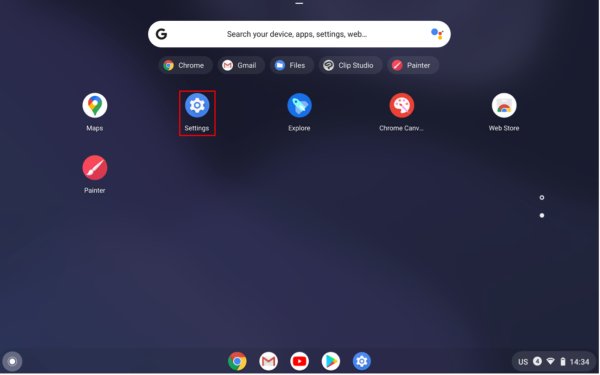
- Click on Advanced at the left menu bar.
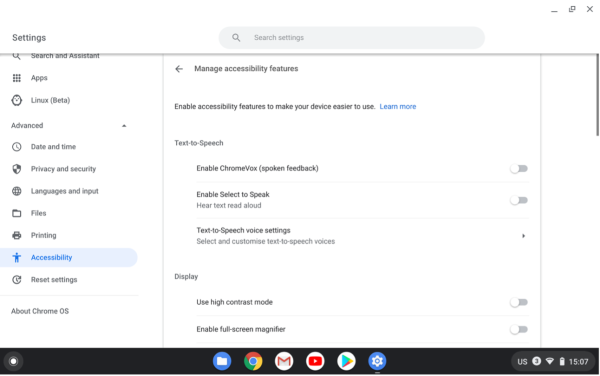
- Click on Accessibility.
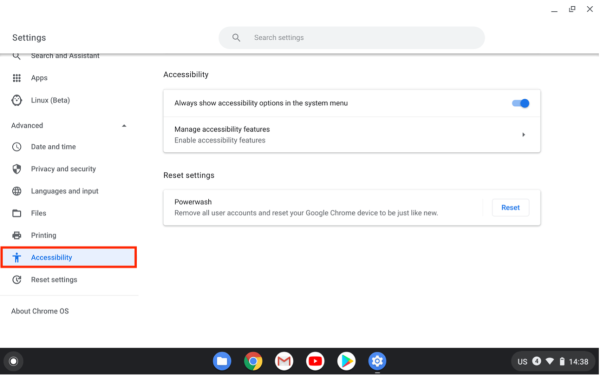
- It will produce a screen with all accessibility features.
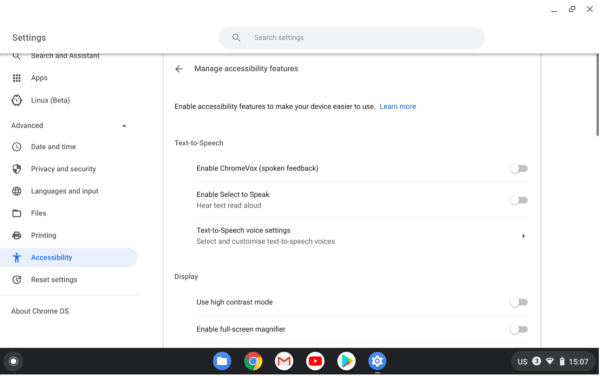
Vision-Related
1. Text-to-Speech
1.1. Enable ChromeVox (spoken feedback)
Chromebooks have a built-in screen reader called ChromeVox that makes Chrome Operating System accessible to the visually impaired. To enable ChromeVox users will need to:
- Go Settings.
- Go to Accessibility.
- Go to the Text-to-Speech section.
- Turn on Enable ChromeVox (spoken feedback).
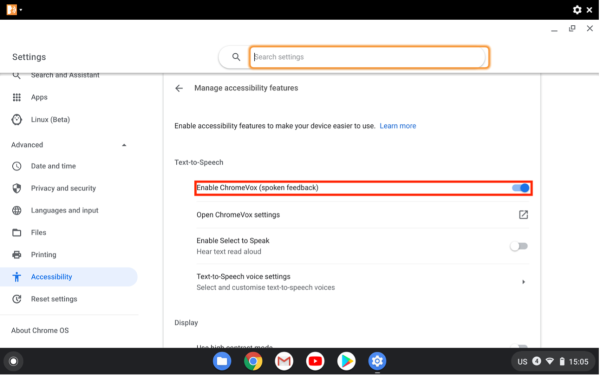
- Now the device will read through the content being selected. Also, the reading section will be circled by a yellow rectangle and reading content will be displayed at the top of the screen.
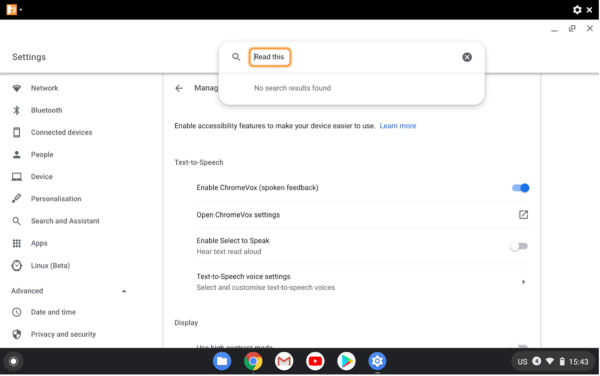
- To change reading content users can use either pointer or press Tab on their keyboard.
- To read the whole page press Search+k.
1.2. Enable Select to Speak
Users can use the Enable Select to Speak feature to make the device read the entire page or just selected parts aloud. To do this user will need to:
- Go to Settings – Accessibility – Text-to-Speech.
- Find and turn on Enable Select to Speak.
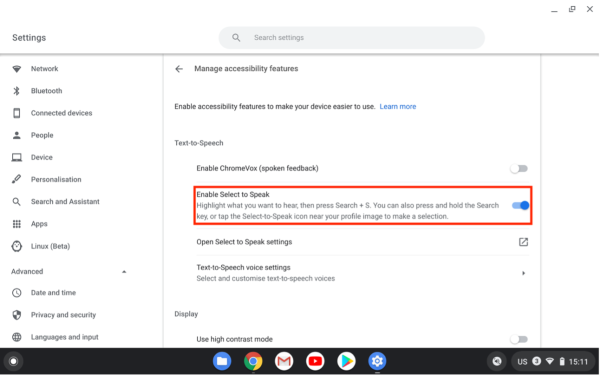
- Highlight the content and press Search+S.
- The reading content will be highlighted by the purple rectangle.
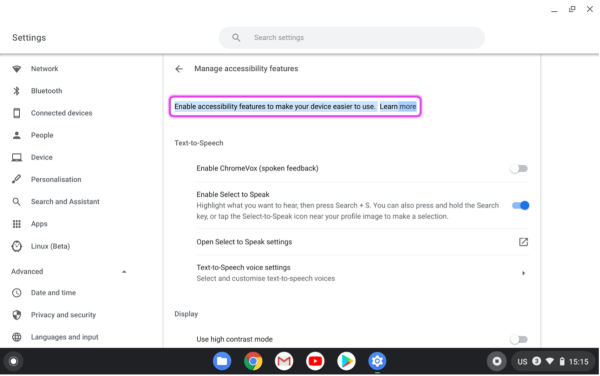
1.3. Open Select to Speak settings
Users can also access Select to Speak settings to change elements according to their preferences. To do this user will need to:
- Go to Settings – Accessibility – Text-to-Speech
- Click Open Select to Speak setting
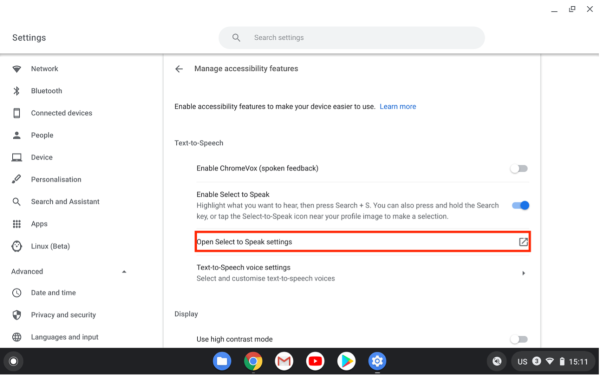
- Users can now change their speaking voice under the Speech section.
- Language: The user can select which language to use.
- Preferred voice: The user can select what voice to use.
- Use natural voice when the device is online: To use a more realistic, lifelike voice, select Use natural voice when the device is online.
- Natural voice: The user can select what natural voice to use.
- Voice preview: The user can hear the voice in advance before applying the settings.
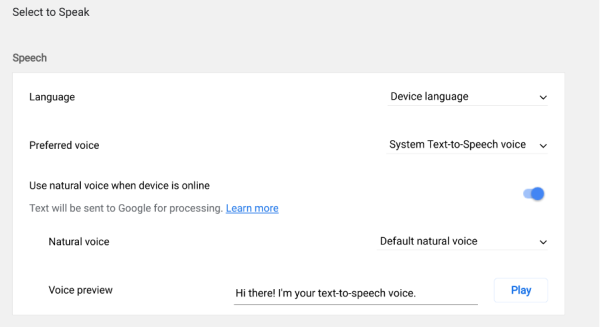
- There are more functions related to highlighting under the highlighting section:
- Highlight each word as it is spoken: This will highlight the reading content while the system reads it.
- Colour for word highlights: The user can select the colour of the highlighted word.
- Shade background content: System will shade the background while it’s reading.
- Enable navigation controls: Provides options for users to speed up or slow down the reading voice.
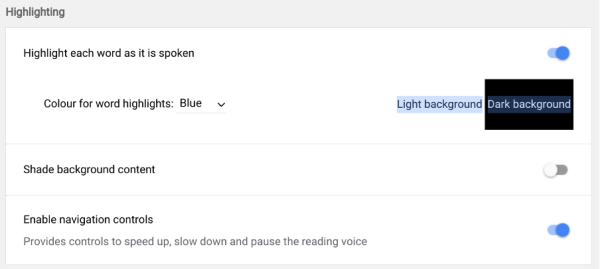
1.4. Text-to-Speech voice setting
Users can customise text-to-speech voice by:
- Go to Settings – Accessibility – Text-to-Speech.
- Find and click on Text-to-Speech voice settings.
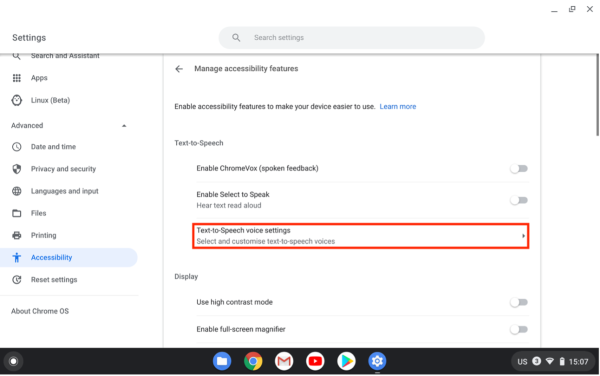
- Users can change Rate, Pitch, Volume and Language.
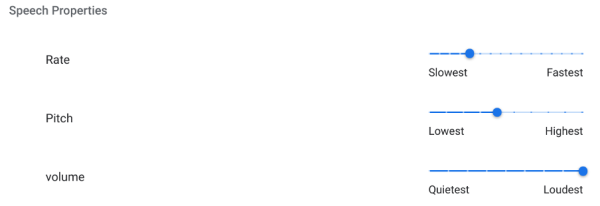
2. Display
2.1. Use high contrast mode
High Contrast Mode is an accessibility feature that helps people with low vision improve readability by changing page colours. To use this feature:
- Go to Settings – Accessibility – Display.
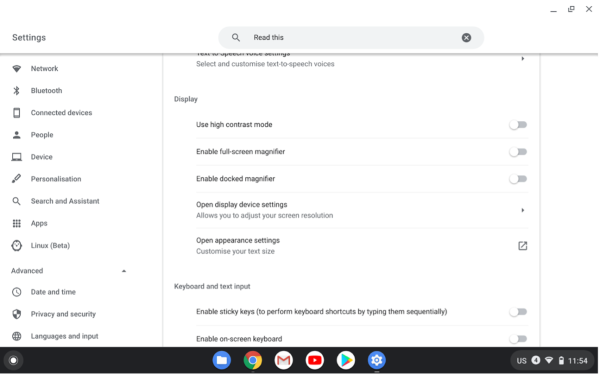
- Turn on high contrast mode
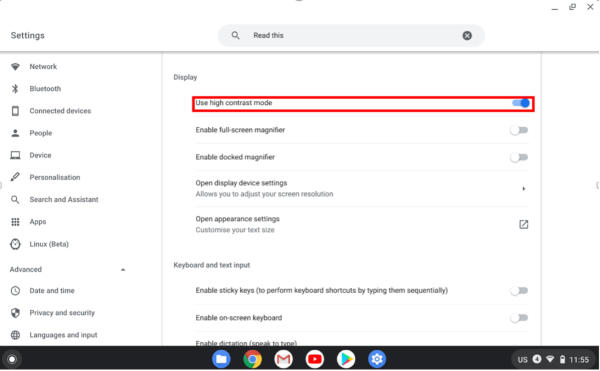
2.2. Enable Full-Screen magnifier
Full-screen magnifying allows users to browse the enlarged screen, and the magnification can be adjusted according to the user’s needs. To use this function:
- Go to Settings – Accessibility – Display.
- Turn on the full-screen magnifier.
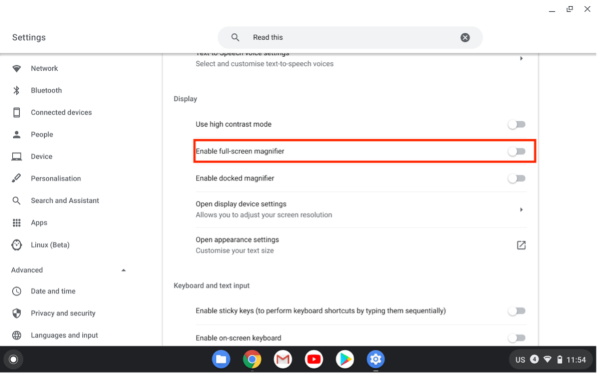
- Click on the Full-Screen zoom level to adjust the magnification.
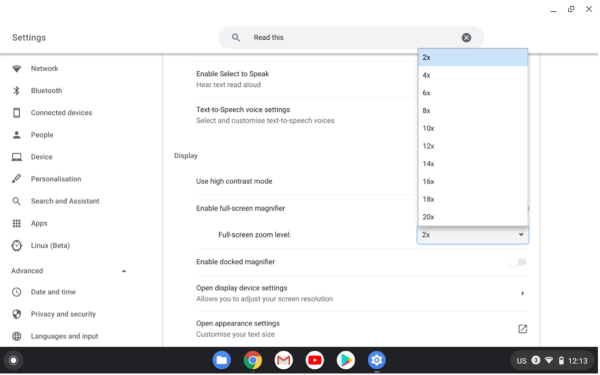
2.3. Enable docked magnifier
Docked magnifier will zoom in on the section where the pointer is and display it at the top of the screen instead of zooming in on the entire screen.
- Go to Settings – Accessibility – Display.
- Turn on Enable docked magnifier.
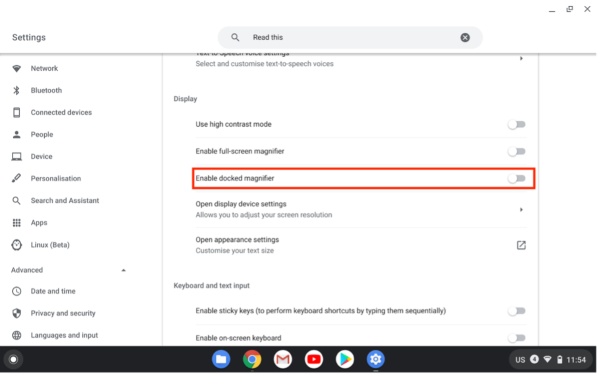
- Users can also adjust the magnification by clicking Docked zoom level.
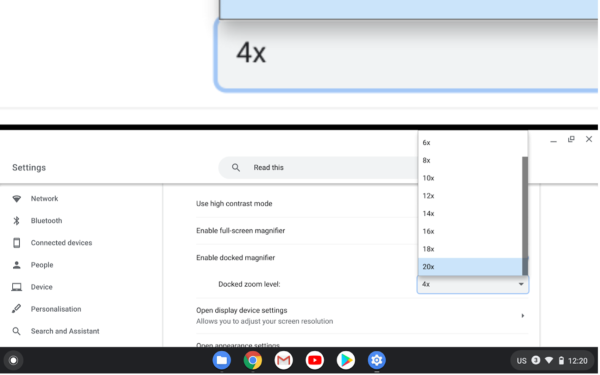
2.4. Open display device settings
Display device settings allow users to adjust their screen resolution according to their preferences.
- Go to Settings – Accessibility – Display.
- Click on Open display device settings.
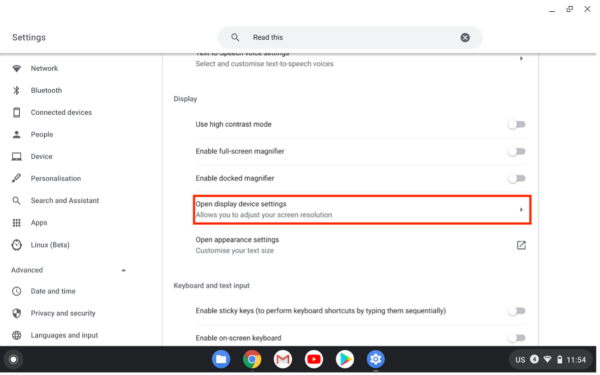
- Users can then change the Display size or Orientation.
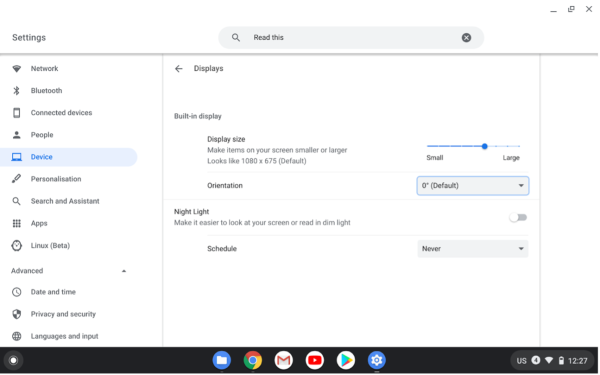
- Users can also turn on the Night light to make it easier to read in dim light.
2.5. Open Appearance settings
This function allows the user to customise text settings.
- Go to Settings – Accessibility – Display.
- Click on Open appearance settings.
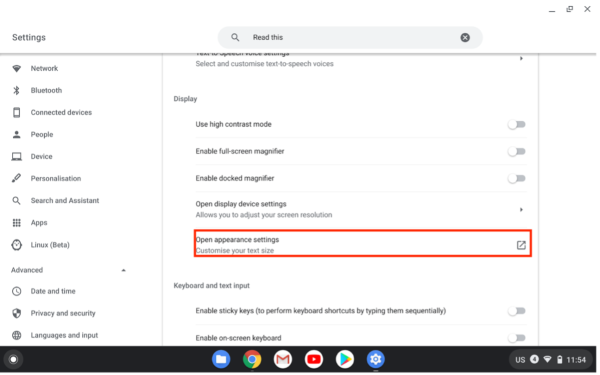
- Users can now access settings including:
- Show Home button: Display the home button in the browser tab.
- Show bookmarks bar: Display the bookmark bar in the browser tab.
- Font Size: Change the font size.
- Customise fonts: Choose between different font types.
- Page zoom: Adjust the zoom level for the browser.
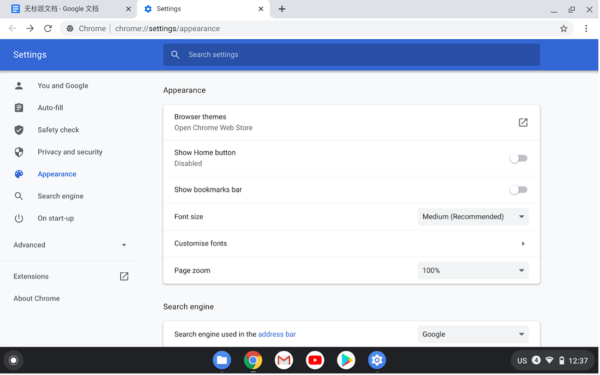
3. Mouse visibility options
3.1. Show large mouse cursor
This feature will magnify the cursor to help people with low vision locate the cursor easier. To activate this user will need to:
- Go to Settings – Accessibility – Mouse and touchpad.
- Turn on the toggle of Show large mouse cursor.
- Now the cursor is magnified already, and users can adjust the size of the cursor magnification by sliding left and right.
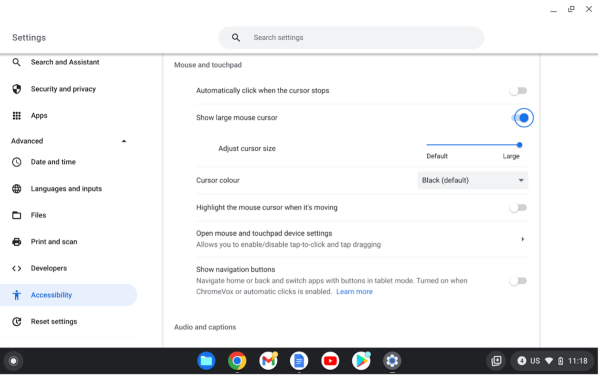
3.2. Cursor Colour
This feature allows users to adjust the colour of the cursor to help them use the device better, especially for people with visual impairments. To activate this user will need to:
- Go to Settings – Accessibility – Mouse and touchpad.
- Click on the drop-down menu and select cursor colour
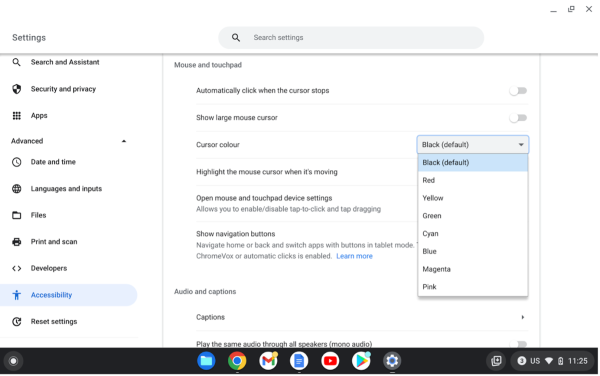
3.3. Highlight the mouse cursor when moving
This feature will highlight the cursor when it’s moving to help users locate the cursor easier, especially for people with visual impairments. To activate this user will need to:
- Go to Settings – Accessibility – Mouse and touchpad.
- Turn on the toggle of Highlight the mouse cursor when moving.
- The cursor is now highlighted by an orange circle when moving.
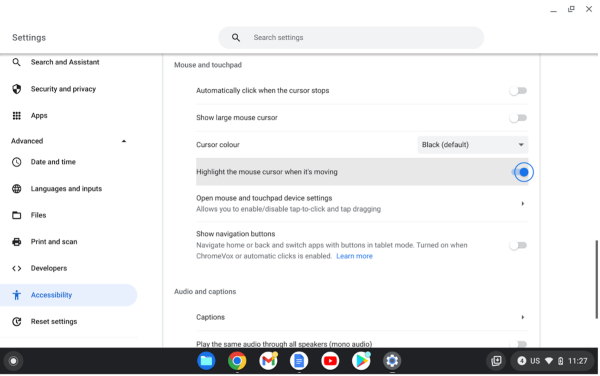
Hearing-Related
1. Audio and captions
- Go to Setting.
- Go to Accessibility.
- Scroll down to Audio and captions.
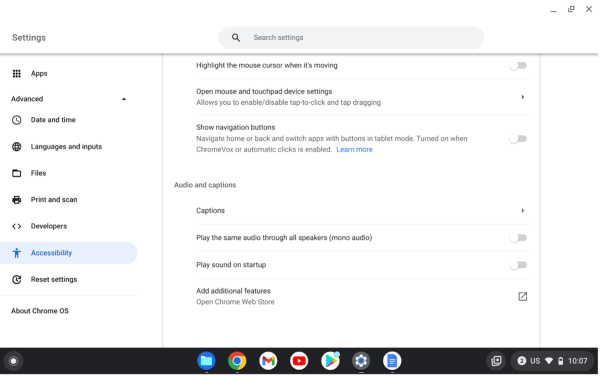
1.1. Captions
This function will automatically generate captions when audio/video plays. To do this user will need to:
- Go to Settings – Accessibility – Audio and captions.
- Click on Captions.
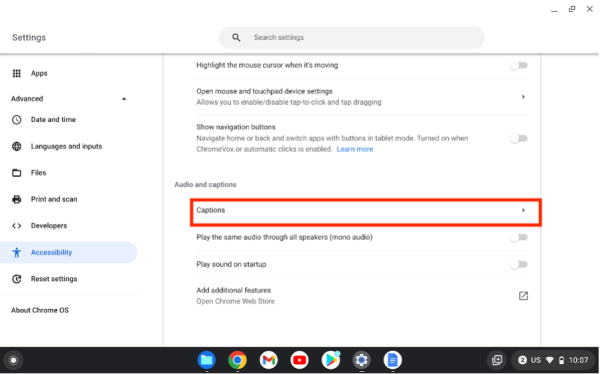
- Live Captions: turn on the toggle so the device will automatically create captions for media in Chrome Browser.
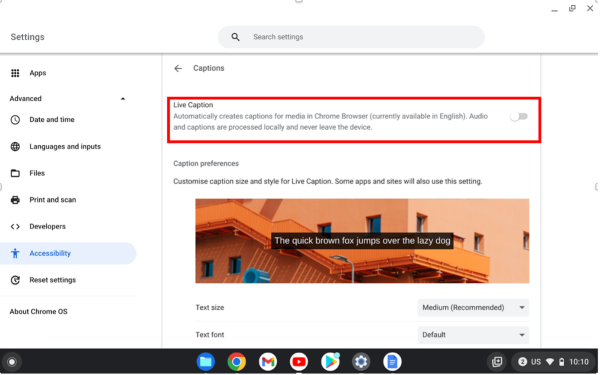
- Caption preferences:
- Text size: Choose the caption text size.
- Text font: Choose the caption text font.
- Text colour: Choose the caption text colour.
- Text opacity: Choose the caption text opacity.
- Text shadow: Choose the caption text-shadow.
- Background colour: Choose the background colour.
- Background opacity: Choose the background opacity.
1.2. Play the same audio through all speakers (mono audio)
This function will make the device play the same audio through all speakers (mono audio). To do this user will need to:
- Go to Settings – Accessibility – Audio and captions
- Click on Play the same audio through all speakers (mono audio)
- Turn the toggle on
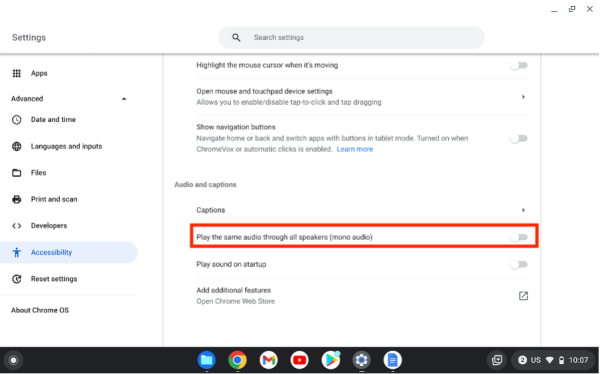
1.3. Play sound on start-up
This function will play a start-up sound when the device is turned on. To do this user will need to:
- Go to Settings – Accessibility – Audio and captions.
- Click on Play sound on start-up.
- Turn the toggle on.
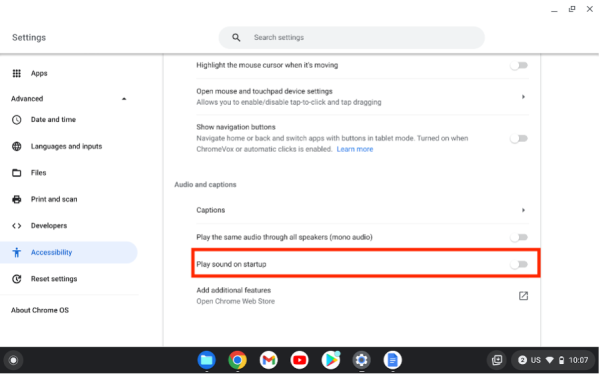
General and Mobility-Related
1. Keyboard and text input
- Go to Setting.
- Go to Accessibility.
- Scroll down to Keyboard and Text Input.
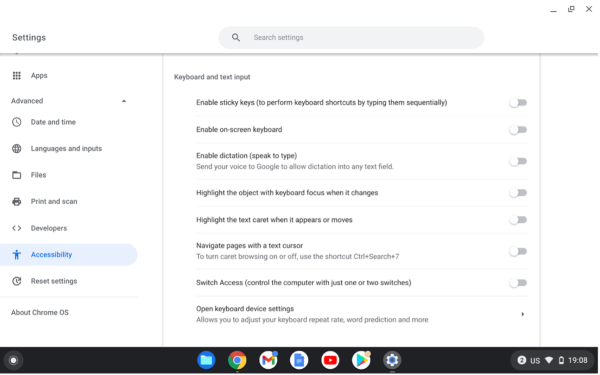
1.1. Enable sticky keys
Sticky keys enable users to press the combination keys respectively instead of pressing multiple keys at the same time. To active this function user needs to:
- Go to Settings – Accessibility – Keyboard and text input.
- Find Enable sticky keys.
- Switch the toggle on.
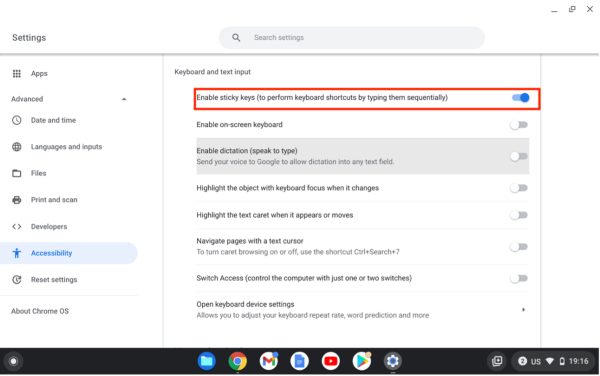
- Now users can press keys respectively. For example, press Control and then press C to copy instead of press Control + C at the same time. (This part cannot be screenshotted, but it will show in the upper left corner of your device.
1.2. Enable on-screen keyboard
This function will have a virtual keyboard on the screen to enable users to click on keys by using a pointer. To do this users need to:
- Go to Settings – Accessibility – Keyboard and text input.
- Find Enable on-screen keyboard.
- Switch the toggle on.
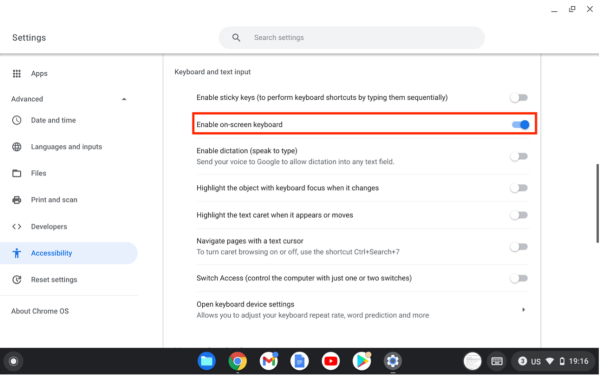
- This virtual keyboard will display on the user’s screen.
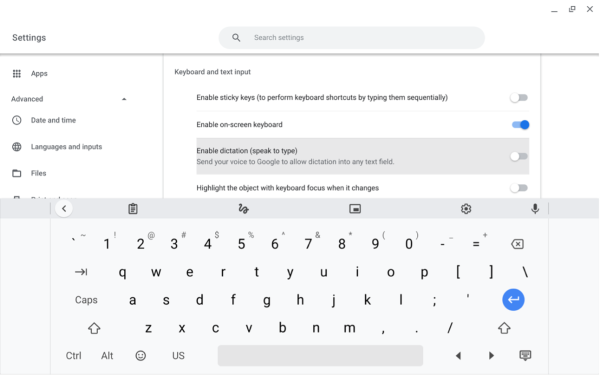
1.3. Enable dictation
This function will record the user’s voice and send it to Google to generate a word and input it where the user is pointing at. To enable this users need to:
- Go to Settings – Accessibility – Keyboard and text input.
- Find Enable dictation (speak to type).
- Switch the toggle on.
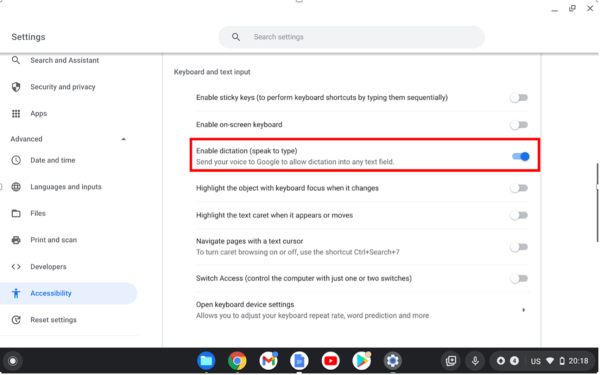
- Now user can click on the microphone icon at the bottom right corner and start speaking.

- After speaking click on the place, you want to enter it all words will be automatically added.
1.4. Highlight the object with keyboard to focus when changes
This function will highlight the section on which the user’s pointer or keyboard is currently focusing. To enable this users need to:
- Go to Settings – Accessibility – Keyboard and text input.
- Select the toggle for ‘Highlight the object with keyboard focus when it changes’.
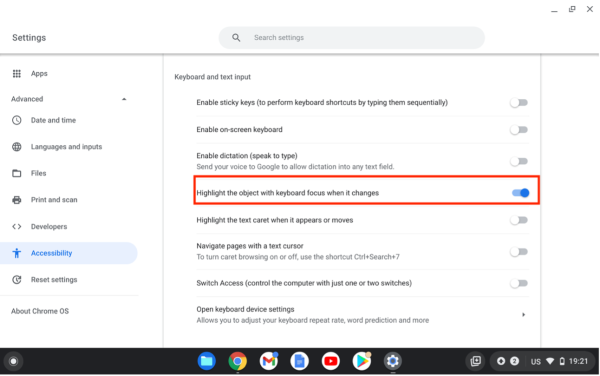
- A yellow rectangle will now highlight where the keyboard is focusing on.
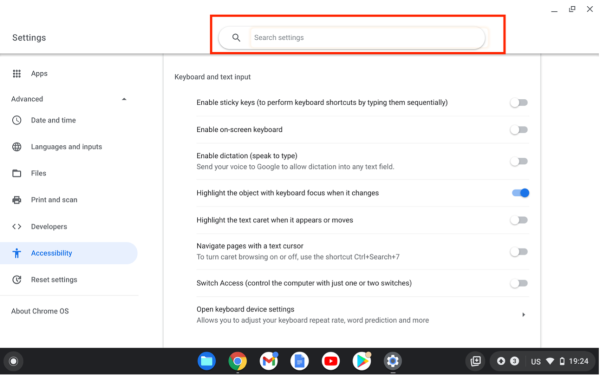
1.5. Highlight the text caret when it appears or moves
This function will highlight where the text caret is when it is moving to help users to know where the text caret is. To enable this users need to:
- Go to Settings – Accessibility – Keyboard and text input.
- Find Highlight the object with keyboard focus when it changes.
- Switch the toggle on.
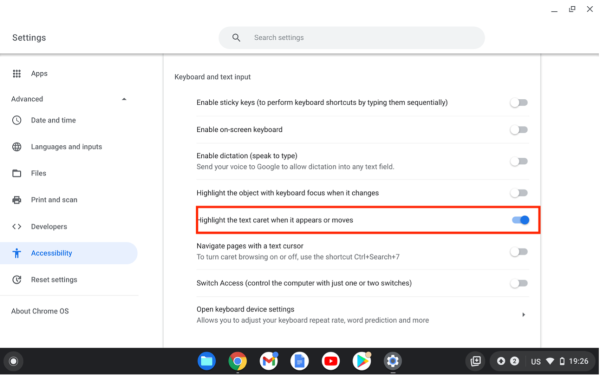
- Now the device will highlight the text caret by a purple circle.
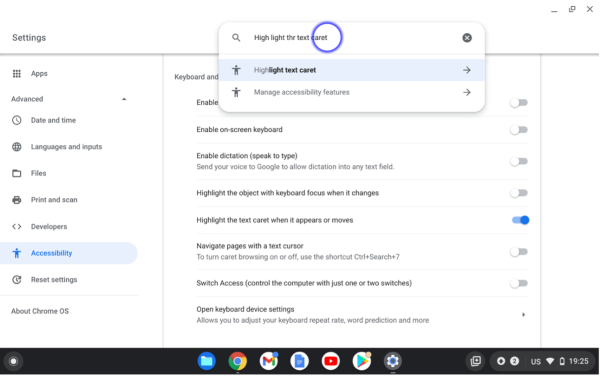
1.6. Navigate pages with a text cursor
To enable this users need to:
- Go to Settings – Accessibility – Keyboard and text input.
- Find Navigate pages with a text cursor.
- Switch the toggle on.
- The shortcut to turn it on/off is Ctrl+Search+7.
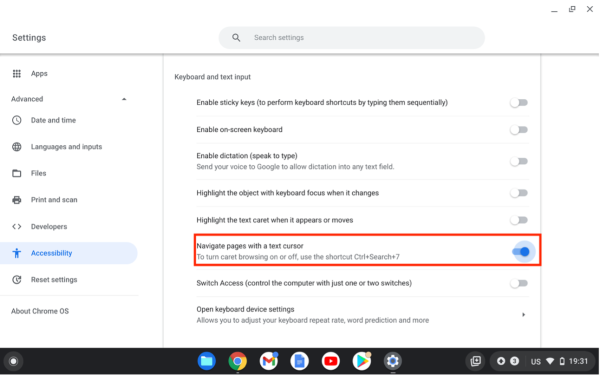
1.7. Switch Access
Switch Access scans the items on the screen until the user selects the switch. To enable this users need to:
- Go to Settings – Accessibility – Keyboard and text input.
- Find Switch Access.
- Switch the toggle on.
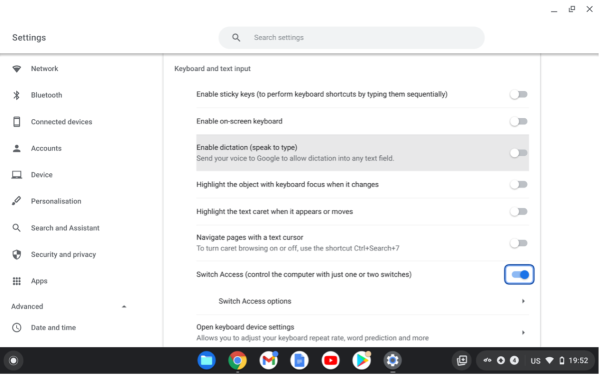
- Users can also click on Switch Access Options to make changes to their preferences.
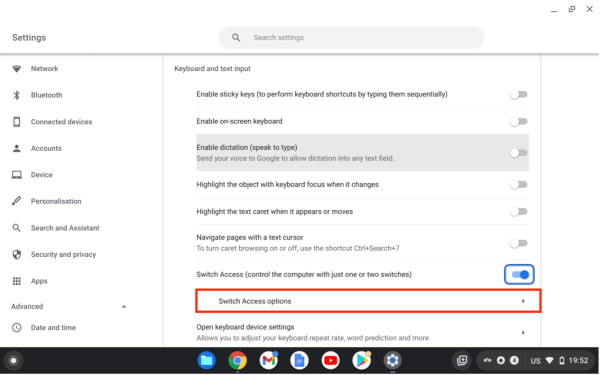
- Switch action assignment:
- Select: Assign a switch to perform action select.
- Next: Assign a switch to perform the next action.
- Previous: Assign a switch to perform the previous action.
- Auto-scan:
- Enable auto-scan: Turn this on to enable the device to do auto scan through the screen.
- Point scanning speed: Adjust the point scanning speed.
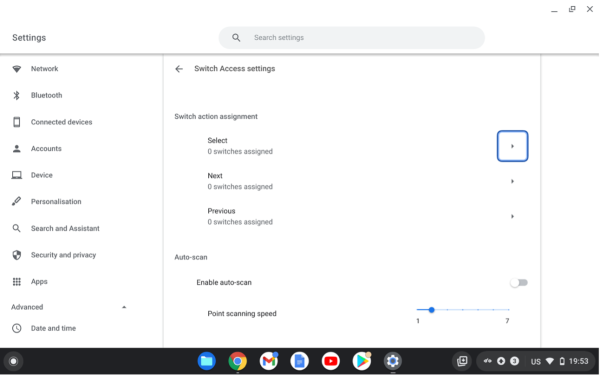
1.8. Open keyboard devices settings
This allows users to adjust their keyboard settings. To do this user will need to:
- Go to Settings – Accessibility – Keyboard and text input.
- Find and click on Open keyboard devices settings.
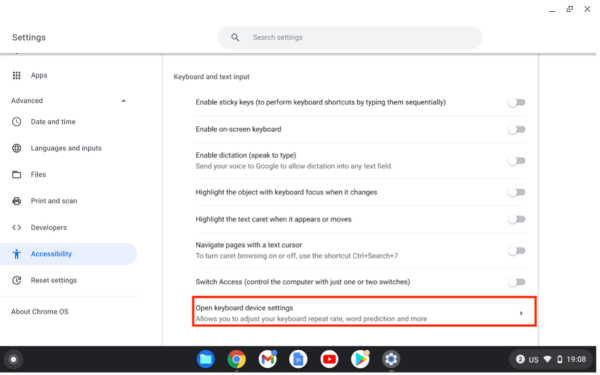
- Users can now set the key to do Search, Ctrl, Alt, Escape and Backspace.
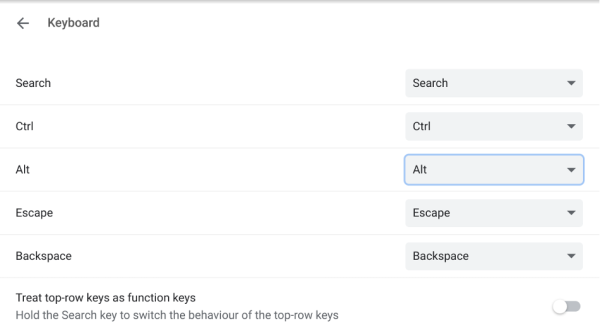
- Users can also change the Delay before repeating and the Repeat rate.
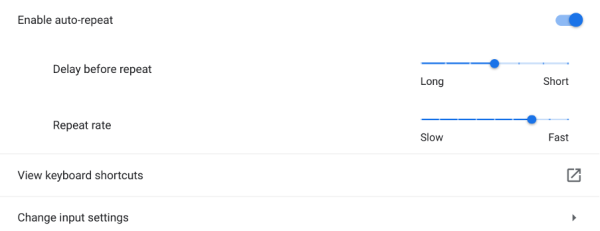
- View keyboard shortcuts will display all keyboard shortcuts, and shortcut types including:
- Popular Shortcuts.
- Tabs & Windows.
- Pages & Web Browser.
- System & Display Settings.
- Text Editing.
- Accessibility.
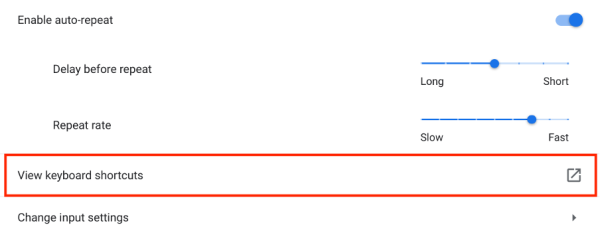
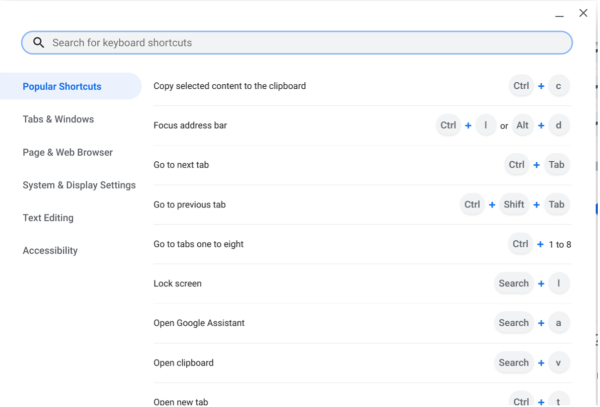
- Users can also change the input settings.
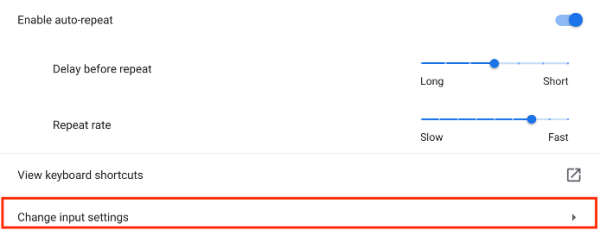
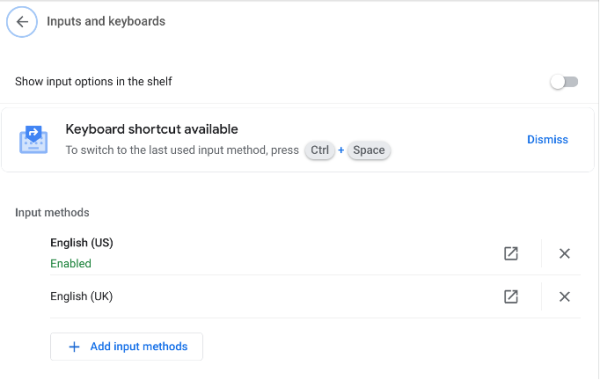
2. Mouse and touchpad
- Go to Setting.
- Go to Accessibility.
- Scroll down to Mouse and touchpad.
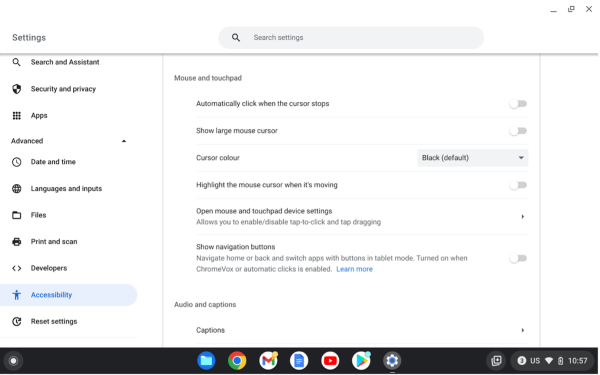
2.1. Automatically click when cursor stops
This function enables the cursor automatically to click after stopped moving. To activate this user will need to:
- Go to Settings – Accessibility – Mouse and touchpad.
- Turn on the toggle of Automatically click when the cursor stops.
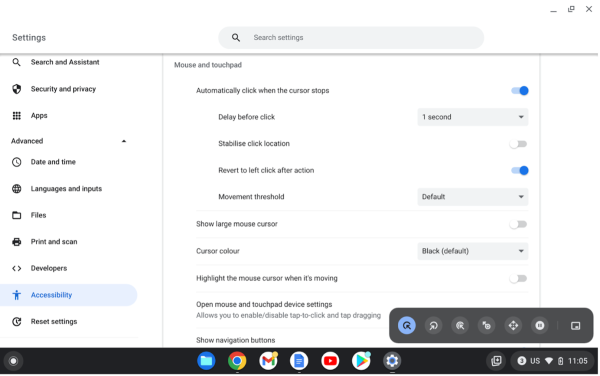
- Now the system will automatically click every time the user stops moving their cursor. Also, users can change settings according to their preferences.
- Delay before click: The click wait time of the device after the cursor stops moving.
- Stabilise click location: Keep the ring in one place until the cursor moves out of it.
- Revert to left-click after action: Automatically return to the left button click after other operations, such as right-click or double-click.
- Movement threshold: Resize the ring.
2.2. Open mouse and touchpad device settings
This feature allows users to make changes to the setting according to their preferences. To activate this user will need to:
- Go to Settings – Accessibility – Mouse and touchpad.
- Click on Open mouse and touchpad device settings.
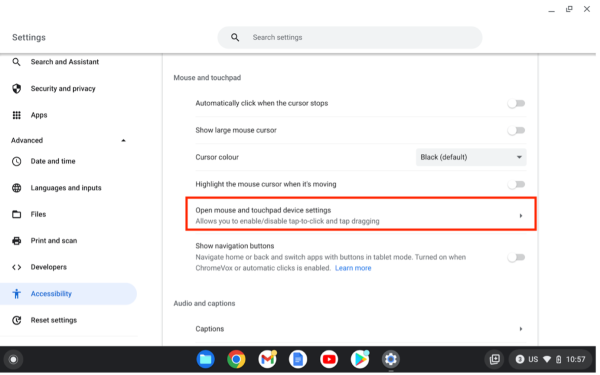
- Functions include:
- Enable tap-to-click: Perform a click by lightly tapping instead of clicking.
- Enable tap dragging: Enable double-tapping and then start dragging.
- Enable touchpad acceleration: When enabled, the distance your pointer moves across the screen will depend on how quickly you move your mouse.
- Touchpad speed: Adjust touchpad speed by using the slider.
- Enable reverse scrolling: When enabled, the screen will scroll in the same direction as the finger scroll direction.
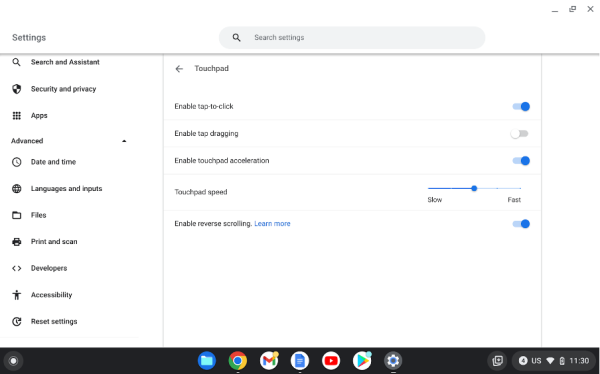
2.3. Show navigation button
Navigate home or back and switch apps with buttons in table mode. Turned on when ChromeVox or automatic clicks is enabled. To enable this function:
- Go to Settings – Accessibility – Mouse and touchpad.
- Turn on the toggle of the Show navigation button.
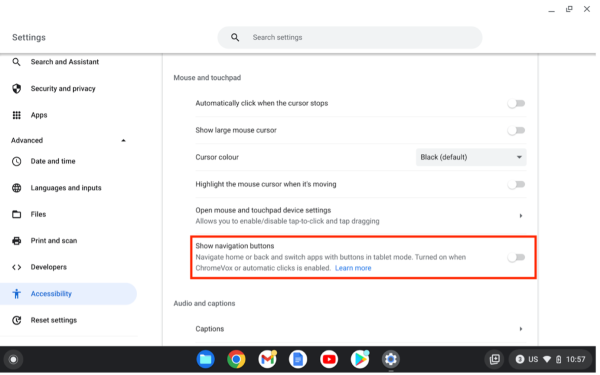
- The navigation button will now appear at the bottom of the screen and the user can interact with it.
3. Add additional features
This function allows the user to purchase/download additional features from Chromebook online shop and install them on their device. To do this user will need to:
- Go to Settings – Accessibility – Audio and captions.
- Click on Add additional features this will bring the screen to a web page.
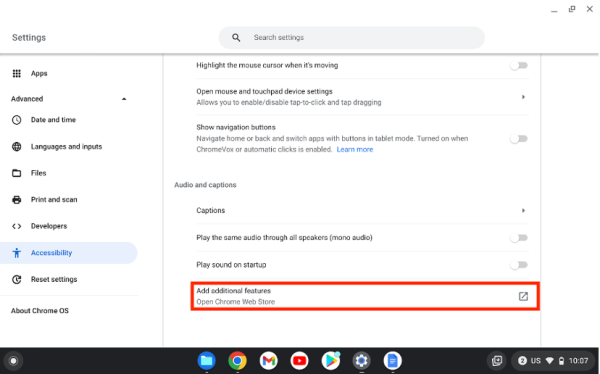
- Search and download the features you want to add to your device.
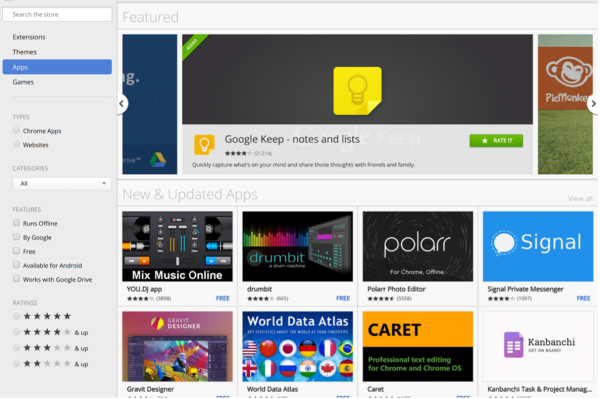
Keyboard Shortcuts
The search key is located at the very left side of the keyboard with a search symbol. Ctrl key is located at the bottom left corner of the keyboard.
1. Enable ChromeVox (spoken feedback)
- Change to next reading content: Tab/Click pointer
- Read through whole page: Search + K
2. Enable Select to Speak
- Read the selected content: Search + s
3. Navigate pages with a text cursor
- Turn on/off the function: Ctrl+Search +7
Additional Resources
To learn more about the accessibility features found on Chromebook, visit the official website through the following link: https://support.google.com/chromebook/answer/177893?hl=en
